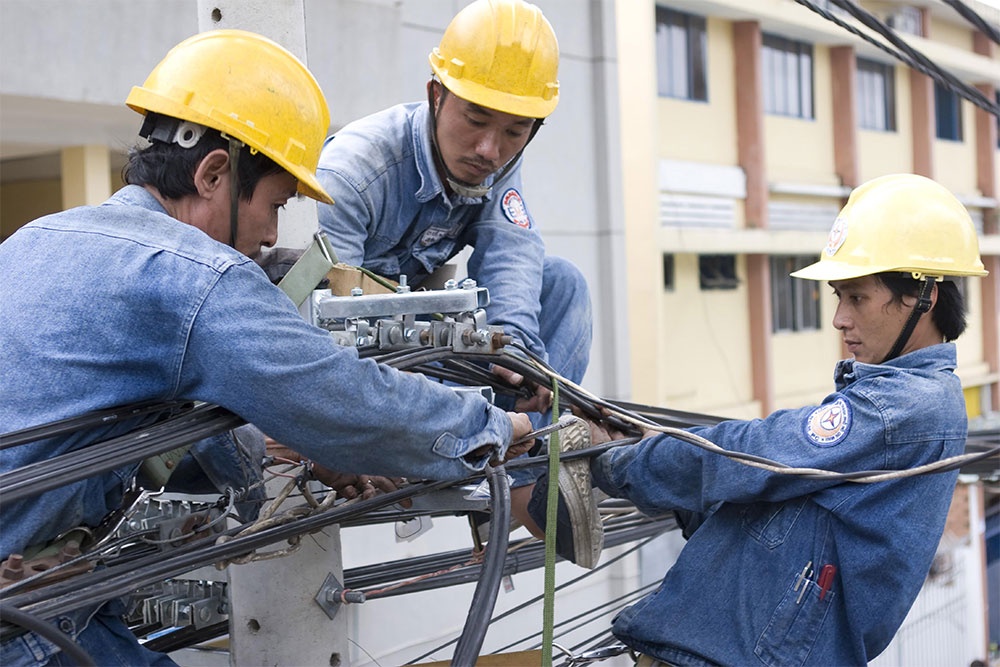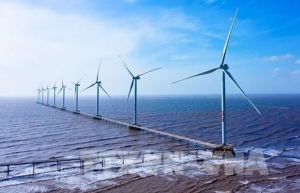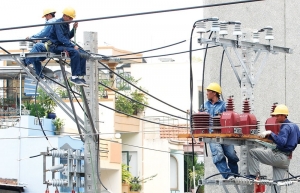Inflation threat with rising power costs
Vietnam’s economy faces an increase in power prices for the first time since 2019. The minimum and maximum average retail electricity pricing structures have been in effect since February 3, with rates of 7.7 and 10 cents per kWh, respectively. The average retail electricity price band serves as the government’s floor and ceiling for determining the official retail power price.
 |
| There is currently no formal decision about the rise in power prices, photo Le Toan |
The Ministry of Industry and Trade (MoIT) demanded that Electricity of Vietnam (EVN) finish the plan for the average retail price of power in 2023 within a month. While input prices have grown, the retail price of energy has been fixed for over four years, resulting in a price that is far below cost. EVN lost around $1.32 billion in 2022 owing to their inability to meet the cost of purchasing power.
Chairman of the Vietnam Valuation Association and former director of the Department of Price Management at the Ministry of Finance, Nguyen Tien Thoa, is “not surprised” by the significant loss in the electrical business. According to him, the fuel used to produce energy in Vietnam is affected by global costs. “In 2022, the global coal price was six times higher than it was in 2020 and around 2.6 times higher than it was in 2021, and the cost of power production accounts for 80 per cent of energy pricing,” he said.
Thoa determined that the cost of purchasing power from facilities utilising imported coal rose by almost 25 per cent between 2021 and 2022, from 6.9 to 8.8 US cents per kWh. In the meanwhile, the oil price in 2022, which serves as the foundation for calculating gas pricing for gas-fired power plants, has climbed about 2.2 times compared to 2020 and approximately 1.3 times compared to 2021.
Do Thang Hai, Deputy Minister of the MoIT, said that the present policy provides an “assurance mechanism” for power prices to closely track input costs, reflecting market price changes in the average retail price of energy.
Decree No.24/2017/QD-TTg released in 2017 on mechanism for adjustment of average retail electricity price outlines the procedure for changing power rates throughout the year. In the event that a change in input parameters during the generation stage causes the average retail price of electricity to rise 3 per cent or more, the price of electricity can increase. Decision 24 specifies that the average time for adjusting the average power price must be at least six months after the last adjustment.
Hai mentioned particular power tariffs and seasonally variable generation costs. “During the rainy season, hydroelectricity mobilises a greater quantity of power, and the cost of production is reduced owing to the abundance of water in lakes,” he said. “During the dry season, however, the output mobilised from hydropower plummets due to a shortage of water, while the cost of energy mobilised from other sources, such as thermal power and gas power, increases.”
Several experts hold that in 2023 it will be acceptable for inflation to grow at a rate higher than 3.15 per cent in order to limit the price increase of certain vital items. The consumer price index (CPI) grew by 4.9 per cent annually in January 2023, the highest level since March 2020. Specifically, in the transportation category, the CPI grew by 1.4 per cent compared to the previous month as fuel prices increased.
Dinh Quang Hinh, an analyst with VNDirect Securities, said, “The manufacturing industry’s outlook will continue to deteriorate over the next months.” Data from the General Statistics Office indicate that in January, Vietnam’s index of industrial output fell 14.6 per cent on-month and 8 per cent on-year, as a result of a steep decline in the number of orders.
The purchasing managers’ index improved to 47.4 points in January from 46.4 points the previous month, but has remained below the 50-point benchmark for three consecutive months.
The industrial items with positive growth in January were crude iron and steel, which increased 4.3 per cent from January 2022. Nevertheless, the list of industrial items with negative growth also includes bar and angle steel, down 26.2 per cent from a year earlier, and rolled steel, down 25.6 per cent.
Hinh said, “We expect inflation pressure to continue to be elevated during the first half of 2023.”
There is currently no formal decision about the rise in power prices. Nevertheless, last week’s meeting between the MoIT and EVN continued to concentrate on drafting a plan for average retail price of electricity, investment in energy source and grid projects, and EVN’s fiscal balance.
| Nguyen Hong Dien-Minister of Industry and Trade
Plans are being made to alter the average retail power price in 2023. The MoIT has instructed EVN to strictly adhere to and comply with the method for revising the average retail price of energy as specified in Decision 24 of 2017. The modification of electricity costs must be estimated, analysed, and regulated in line with the influence on inflation, people’s lives, and the government’s macroeconomic management. In addition, the MoIT instructed EVN to actively participate in amending and supplementing regulations on the framework for adapting retail electricity prices, the energy retail tariff formation in the prime minister’s decisions, the power price mechanism, the electricity market in the Law on Electricity, and direct power purchase agreements to guarantee that electricity rates fully reflect market factors, creating a level playing field among parties. Nguyen Thu Oanh, Director of Price Statistics General Statistics Office
In 2023, keeping inflation below 4.5 per cent will be tough. Importing raw resources at a high price will affect prices, place strain on output, consequently increasing the price of local consumer products, and exert pressure on the economy’s inflation rate. According to statistics, the price index of raw materials for manufacturing in 2022 grew by 6.79 per cent compared to 2021, the largest rise in the previous decade. The commodity import price index grew by 8.56 per cent, the largest rise since 2012, while imports of manufacturing materials accounted for more than 90 per cent of Vietnam’s import turnover value. In addition, the implementation of price adjustments for state-managed commodities will affect the CPI in 2023 as a result of the adjustment of prices for education and health services, which account for roughly 12 per cent of the CPI bundle of products. Dr. Can Van Luc, Member National Fiscal and Monetary Policy Advisory Council
Rising power costs may cause inflation to rise, but this must be tolerated in order to help the electrical business cut losses and maintain the industry’s investment appeal and efficiency. Nevertheless, the rise in energy prices must be analysed to determine the magnitude of the increase and when to implement the new price in order to prevent a simultaneous economic effect. The government should assess whether the degree of adjustment, from 5 to 7 per cent, is commensurate with the projection of high inflation and ongoing economic challenges for this year. If the price of energy rises by 7 per cent, like in 2022, EVN’s income will increase by $1.32 billion, which is sufficient to pay the cost of power generation. The World Bank predicted that commercial electricity generation will grow by 9 billion kWh and energy costs will decline by around 11 per cent in 2023, allowing EVN to earn substantial profits. |
| According to Decision No.02/2023 on the average retail electricity price bracket, effective February 3, the minimum average retail price of electricity will increase by 0.9 US cents per KWh and the maximum average retail price will increase by 2.3 US cents per KWh, which corresponds to a rate of increase of 13.7 per cent and 28.2 per cent, respectively. EVN delivered over 242 billion kWh of commercial power in 2022. At a current average price of 7.8 cents per kWh, EVN’s total power industry income is around $19 billion. The General Statistics Office cautioned that an increase in power costs would exert pressure on inflation; a 10 per cent increase in electricity prices will affect the CPI by 0.33 percentage points, and the expiration of several tax reduction initiatives will lead commodities prices to rise proportionally. |
 | Vietnam to cut gas power capacity in electricity development plan The Ministry of Industry and Trade (MoIT) has been told to finalise the National Power Development Plan VIII (PDP VIII) for 2021-2030 with a vision to 2045, focusing on reducing coal power plants. |
 | Fresh approaches sought for electricity transmission The plan to raise transmission tariffs for energy indicates that Vietnam must take further steps to alleviate system stress and entice private sector investment in transmission. |
What the stars mean:
★ Poor ★ ★ Promising ★★★ Good ★★★★ Very good ★★★★★ Exceptional
Related Contents
Latest News
More News
- Driving double-digit growth through green and circular transformation in Vietnam (December 17, 2025 | 09:00)
- Standard Chartered and ACCA deepen collaboration to develop Vietnam’s talent for a sustainable future (December 15, 2025 | 18:18)
- Schaeffler reports strong early output from Dong Nai solar project (December 12, 2025 | 15:16)
- Forestry conference highlights biodiversity and sustainability goals (December 09, 2025 | 13:35)
- Home Credit honoured among top 10 sustainable companies in trade and services (December 09, 2025 | 12:18)
- SCG and seven member companies honoured in Top 100 Sustainable Businesses 2025 (December 08, 2025 | 09:00)
- Nestlé Vietnam pioneers sustainable development and promotes business connections (December 06, 2025 | 12:09)
- CSI 2025 highlights rise of Vietnam’s green champions (December 06, 2025 | 09:00)
- Acecook Vietnam named among top 100 sustainable businesses (December 06, 2025 | 08:00)
- Vietnam’s forest carbon credits draw global interest (December 05, 2025 | 17:41)




 Tag:
Tag:





















 Mobile Version
Mobile Version